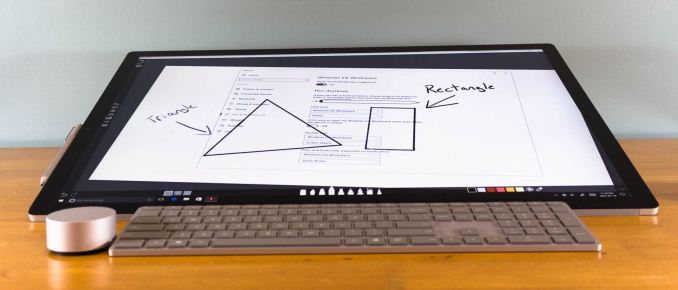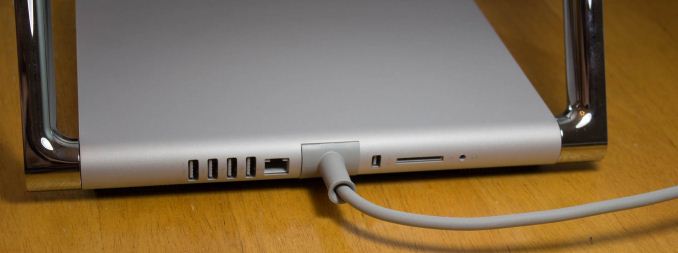The Microsoft Surface Studio Review
by Brett Howse on January 20, 2017 8:00 AM EST- Posted in
- Desktop
- Microsoft
- Surface
- Surface Studio
Design and the Zero-Gravity Hinge
Microsoft has built a brand around Surface, and that’s not an easy thing to accomplish. The Surface Studio fits in very well with the design ethos of the rest of the Surface lineup, and there has been quite a bit of attention to details paid in the creation of their first desktop computer. The first, and most obvious, is the finish, which matches perfectly with the other Surface devices, despite being made from aluminum rather than the magnesium alloy used on the portable products.
The 3:2 aspect ratio of the Surface Studio display is now a hallmark of the Surface brand (outside of Surface Hub), and having a taller display makes doing most tasks on a desktop a more pleasant experience. The increased surface area can’t be forgotten either, with the Surface Studio offering 17% more screen real estate than what's arguably the Studio's closest competitor, the 27-inch iMac, which amounts to an additional 54 square inches of display. Widescreen at 16:9 has never been a great aspect ratio for PC tasks, but the proliferation of high definition television seems to have moved the entire industry this way in an effort to save costs. When looking at the price of the Surface Studio, it’s important to remember that the entire display industry has moved to 16:9 as a standard, which impacts the entire supply chain and tooling required. Moving to an aspect ratio outside of 16:9 has large cost implications, but the end results are certainly worth it. Hopefully we will see a few other manufacturers use this as a means to source displays like this, much like the Surface Pro 3 and Pro 4 have ushered in more 3:2 devices at that much smaller size. And speaking of attention to detail, the Surface Studio is actually 28.125-inches diagonal, and as we'll see in a bit, that last 0.125-inches is very important.
It seems with Surface, Microsoft always wants to have a trick up their sleeve. With the original Surface RT and Surface Pro, it was the kickstand, which has been adopted by quite a few manufacturers for their own device since it works so well. When they launched their first laptop, the Surface Book, it was the muscle wire locking mechanism to remove the display from the base, as well as the dynamic fulcrum hinge to make the top-heavy laptop more stable. With the Surface Studio, the zero-gravity hinge is most definitely its signature design feature.
With two chrome arms flanking the base, the Surface Studio can almost effortlessly be folded down into a drafting table. The hinge mechanism provides a perfect counterbalance to the weight of the display, making it feel like it has almost no weight at all. The hinge is a single movement as well, so you don’t tip and fold the screen, but instead folding the screen also causes it to move down. While this does limit the functionality somewhat – for instance, you can't move the screen half way down and then fold it up straight again – the result is truly a wonderful design which almost needs to be seen in person.
Because you can’t tip the screen without folding it, once you stop at any angle, the screen is very solid to work with, although it is the most secure when folded all the way down to the 20° angle. You would think a large desktop display would not be ideal to use with touch, but the Surface Studio zero-gravity hinge invites you to be more interactive with it, by keeping the display close and folding it down when needed. More traditional all-in-one computers with a touch screen are nowhere near as easy to work with, since holding your arm in dead-air can be tiring, but the folded display doesn’t suffer from these burdens.
The PC base also exudes Surface quality, with the signature color, and cooling vents all the way around in the same fashion as the Surface Pro and Surface Book. The PC base can be disassembled from the bottom if required, for access to the storage and fans, but the remainder of the system is soldered to the board as you would expect in a small form factor device like this. The most frustrating part of the Surface Studio base is that all the inputs and outputs are on the rear of the device, so connecting something over USB, or inserting a SD card into the PC, is not as simple as it should be. This is a form over function decision, and it would be nice to see some of the ports offered at least on the side of the base to make it a bit easier to access.
The desktop PC market has not been as exciting to watch as the smaller and more portable laptops and tablets, but the Surface Studio sets a new high mark for desktop PC design and looks. Some of the decisions are form over function, but the majority of the design decisions actually improve the user experience. The zero-gravity hinge is a masterpiece of engineering, with such a smooth action that it really does feel like the display has no mass at all.













197 Comments
View All Comments
vLsL2VnDmWjoTByaVLxb - Friday, January 20, 2017 - link
The second one 3 months in? After Microsoft kept promising driver/firmware updates to address the issues?It's a business laptop that was going to be a test case for our company, selling it isn't our job. Microsoft extended the warranty, and we decided on XPS 15's instead for our fleet. (which work nearly flawlessly in comparison.)
It wasn't capable of reliable external display/peripheral use either, the dock sucked.
Icehawk - Sunday, January 22, 2017 - link
Yeah we have SP3s, 4s, and SBs at my work and none of them work reliably with more than one monitor. Our clients just love that.sprockkets - Saturday, January 21, 2017 - link
Not trying to troll, but that's like every MS computer since forever.I have an Asus computer that can't wake up either with Windows 8 or 10. Works fine with Linux, SuSE 42.1. Yea, linux isn't perfect but MS has had decades to get standby right, and can't.
Remember the last time an ios or android device failed to wake up when hitting the power button? Me either.
philehidiot - Sunday, January 22, 2017 - link
Sprokkets, that's a damned good point. How can waking from a sleep state continue to confuse Microsoft when as you rightly point out, phones do it multiple times a day flawlessly. It's maddening and you can't realistically sleep your PC during critical work without saving everything (and when you've multiple tabs, papers, word, Excel and PowerPoint documents open that's one big pain in the arse).thebuccaneergentleman - Sunday, January 22, 2017 - link
I don't know if EVERY MS computer is like this... Some are and some are not. We deployed hundreds of Surface Pro 1, 2 and 3s over the years at my company. Some were very good... many were not. The higher-ups though decided to pass on the Surface Pro 4 and started to purchase Lenovo laptops. It was a good call. Our IT support cases have dropped into single digits for the new Lenovos. MS had a PERFECT idea with the Surface. I LOVE the concept. But their execution (at least till the Surface Pro 3 as I have not used a SP4) was less than stellar. Too bad. Its hard to rebound from even a small bad batch.niva - Wednesday, January 25, 2017 - link
Yeah that's a ridiculous statement.I've been using linux for about 10 years now on all sorts of computers. Typically you will encounter issues in linux exactly with things like standby and sleep mode, even if everything else works out of the box. Don't even get me started on drivers for new hardware like dedicated graphics or application support. I've stayed with Windows pretty much 100% due to my Photoshop needs. Sure I game some on my desktop too, but these days even that wouldn't be enough.
I love linux, it's great for many things, especially for the price, but the area you brought up as an advantage somehow you're completely wrong about.
This new device from Microsoft is interesting. The price is ridiculous though. I'll wait for future generations and see how things go in the future. As an artist I'm definitely interested in these types of devices.
tamalero - Sunday, January 22, 2017 - link
There are a lot of stuff that Microsoft hs fucked up over the years.For example.. if your monitors turn off (multiple monitors). Your color calibration information resets to default.
Shutting down any monitor will now cause all the icons to switch to the remaining monitor and the color calibration will be lost as well.
Microsoft support tech(from India and Turkey) only kept repeating the same BS recipe of "reboot, didnt work? then boot in safe mode" and then end with "Its working as intended, its not a bug. We will report this to the developers for xxx reason" and nothing..
Rezurecta - Friday, January 20, 2017 - link
MS support is good. Just get you surface exchanged.geekman1024 - Saturday, January 21, 2017 - link
MS support is good, but their hardware products' quality isn't.My Surface 3's pen function is bad straight out of the box, so I have to send it in for repair the day I've got it. The Surface Pen 4 I've bought for the Surface have its bluetooth function working intermittently, most of the time the top button click doesn't work. Then I remembered I used to have a MS wireless laser mouse + keyboard combo which died 3 months after purchase. My XBox 360 RRoD'ed just a few weeks after warranty expired, nice calculation on the MTTF, Microsoft.
Seems like EVERY MS hardware product I owned have to turn bad at some time. Is it my bad luck or MS's QC needs some debugging?
goatfajitas - Monday, January 23, 2017 - link
Exactly... I dont want good support nearly as much as I want it to not break... Same reason I dont buy a Kia with a 10 year 100,000 mile warranty. I dont want it to break and be fixed for free, I want to not be stuck with a broken car I have to deal with regardless of who pays for it. This comment section alone is riddled with Surface Pro and Surface Book users reporting all sorts of issues. Pass. Big time pass.